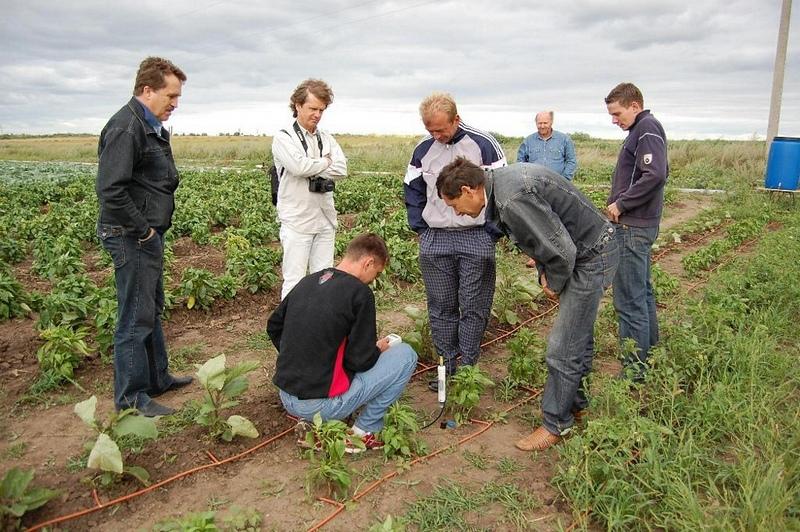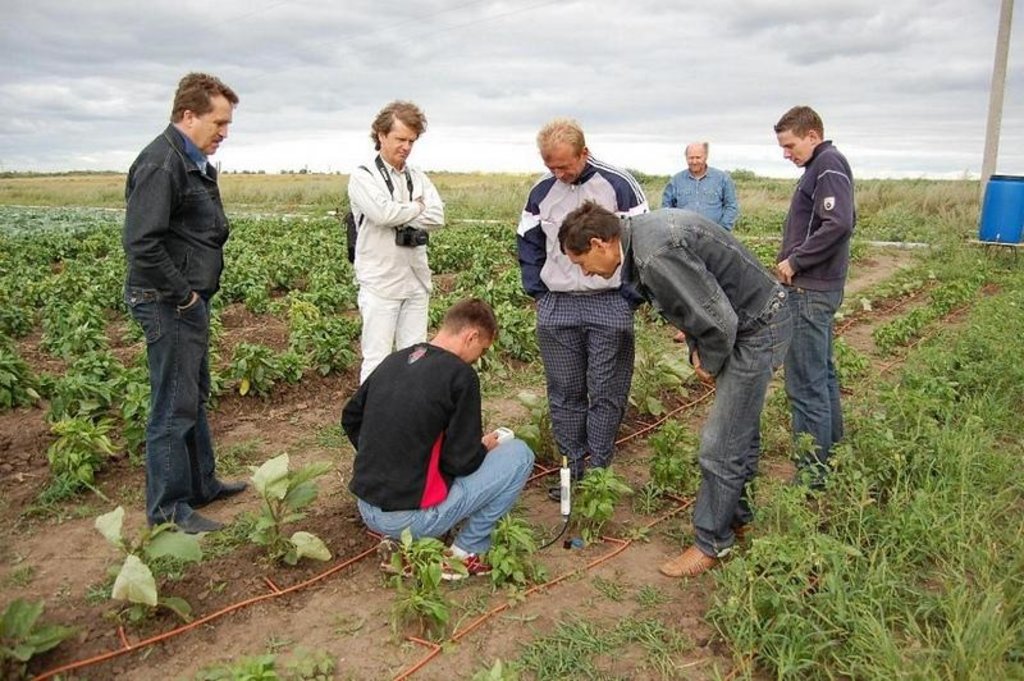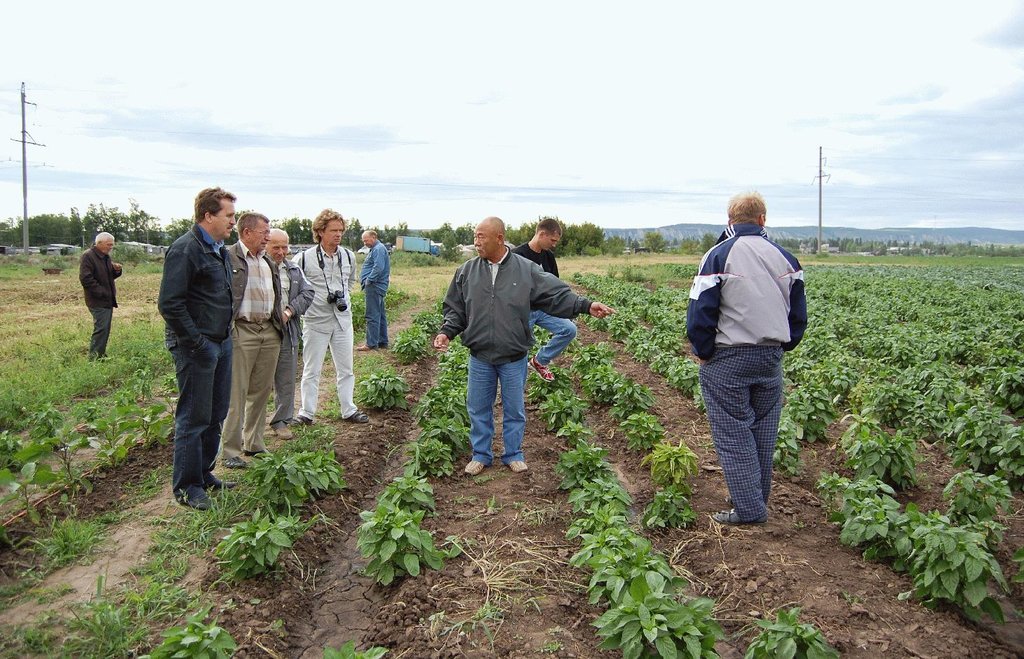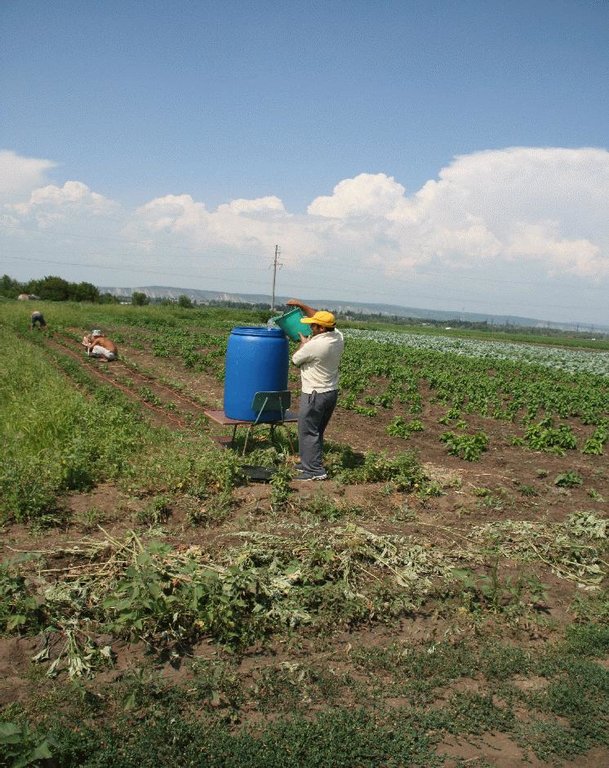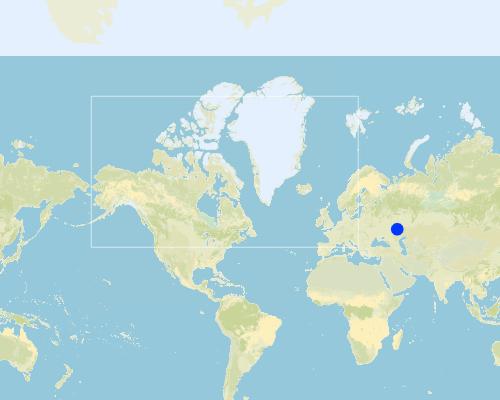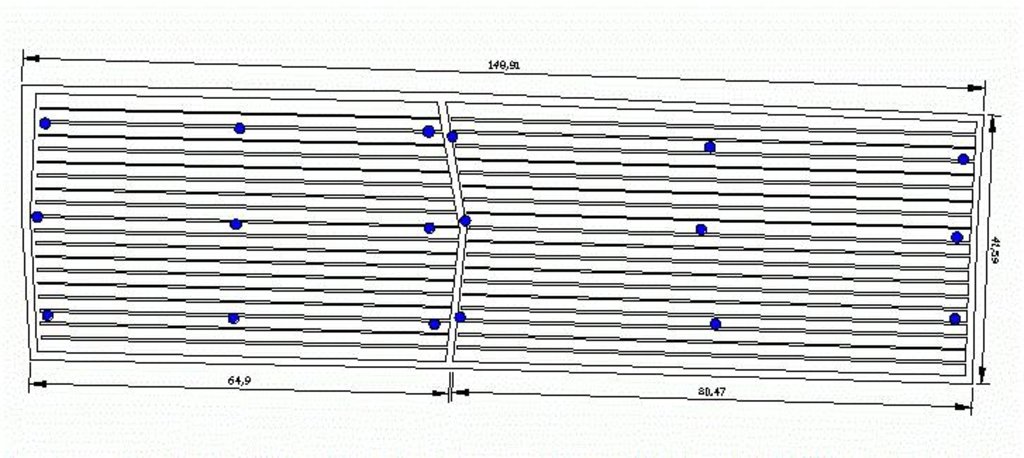Drip irrigation [Russian Federation]
- Creation:
- Update:
- Compiler: Anatoly Zeyliger
- Editor: –
- Reviewer: Deborah Niggli
Капельное орошение (in Russian)
technologies_1371 - Russian Federation
View sections
Expand all Collapse all1. General information
1.2 Contact details of resource persons and institutions involved in the assessment and documentation of the Technology
Name of project which facilitated the documentation/ evaluation of the Technology (if relevant)
DESIRE (EU-DES!RE)1.3 Conditions regarding the use of data documented through WOCAT
When were the data compiled (in the field)?
20/10/2011
The compiler and key resource person(s) accept the conditions regarding the use of data documented through WOCAT:
Yes
1.4 Declaration on sustainability of the described Technology
Is the Technology described here problematic with regard to land degradation, so that it cannot be declared a sustainable land management technology?
No
1.5 Reference to Questionnaire(s) on SLM Approaches
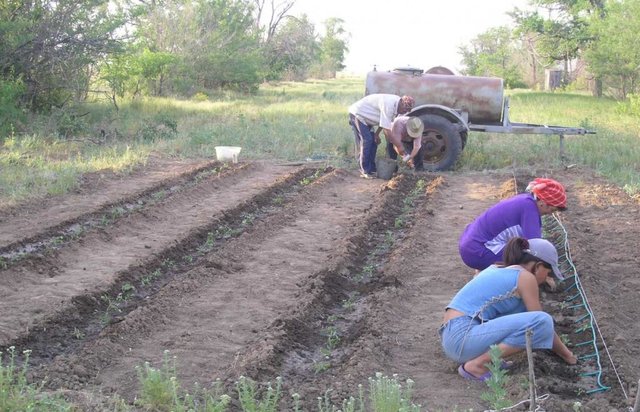
Concerted thinking on common problems of water scarcity [Russian Federation]
Testing and disseminating of a water-saving technology like drip irrigation
- Compiler: Anatoly Zeyliger
2. Description of the SLM Technology
2.1 Short description of the Technology
Definition of the Technology:
Drip irrigation systems gradually apply water into the zone around the stem of the irrigated plant.
2.2 Detailed description of the Technology
Description:
Drip irrigation experiments have been carried out on the left bank of the Volga River. Economic problems, regional reforms and shortage of investments in municipal water supply infrastructure led to problems of water quality and quantity of available water for industrial, agricultural and domestic uses. The situation is getting worse with the effects of regional climate change. Especially during summer, the study region has problems with shortage of water not just for irrigation of agricultural fields, or gardens, but also for domestic use. In such situations, more efficient water use is required through introducing water-saving technologies. One of these well-known irrigation technologies is drip irrigation. Small quantities of water are directly delivered to the plants by a pipe system. This technology is the most effective from the point of view of green water use efficiency. Correct application of drip irrigation technology drastically decreases water losses by runoff and evaporation as well as deep percolation to soil depths inaccessible to root uptake. Water can be provided to plants from surface water reservoirs, water tanks or groundwater wells through a network of plastic pipes (under low water pressure) and delivered through a water drip system. The flow rate can be adjusted to the needs of the particular stage of plant growth, to soil hydraulic properties and to the prevailing weather conditions. The low-pressure supply system can be operated using a header tank or directly by using a water pump to raise water from nearby surface water storage or a groundwater well.
The aim of this technology is to show the effectiveness of freshwater usage in irrigating vegetables (tomatoes, peppers) at the scale of subsidiary plots or small irrigation systems (several ha in size) in a region with scarce water resources both as a water-saving measure and an eco-friendly alternative to furrow irrigation. Owing to the relative narrowness of the drip feeders, they are prone to blockages from organic matter, mineral particles or dissolved compounds. To prolong the lifetime of the drip irrigation equipment, it needs to be maintained using preventive and remedial measures such as visual inspection of pipes and water supply sources, filter installations as well as flushing the tubes and drip emitters to remove deposits.
In general, a number of medium-scale farmers are using furrow irrigation of vegetables as their main agricultural activity. Drip-irrigation technology was tested with four families and compared to furrow irrigation in order to compare water consumption (water use efficiency as rate of yield and volume of water used for irrigation) as well as its impact on soil degradation and ground-water. The water use efficiency of drip irrigation is 3 - 10 times higher than that of furrow irrigation, depending on local conditions and qualification of furrow irrigators. Furthermore, this technology avoids water loss through soil surface evaporation, percolation to deep soil layers and ground water, and runoff into near water bodies (causing pollution by chemicals used for agricultural activities at irrigated fields like fertilizers and plant protectors). The negative impact of furrow irrigation on soil productivity is usually very high due to soil erosion.
Experimentations and demonstration of drip irrigation were done at two levels. The first level involved large-scale farms with the aim of demonstrating the considerable gains to be made through the efficient use of water, through the development of representative experimental plots on fields used for furrow irrigation by two farmers. The second level was developed for small-scale farmers and householders to demonstrate the efficiency of water saving in gardening.
2.3 Photos of the Technology
2.5 Country/ region/ locations where the Technology has been applied and which are covered by this assessment
Country:
Russian Federation
Region/ State/ Province:
Saratov Region
Further specification of location:
Marksovsky District
Map
×2.6 Date of implementation
If precise year is not known, indicate approximate date:
- less than 10 years ago (recently)
2.7 Introduction of the Technology
Specify how the Technology was introduced:
- through projects/ external interventions
3. Classification of the SLM Technology
3.1 Main purpose(s) of the Technology
- reduce, prevent, restore land degradation
3.2 Current land use type(s) where the Technology is applied

Cropland
- Annual cropping
Comments:
Major land use problems (compiler’s opinion): Scarcity of fresh water resources, change of local seasonal climate patterns related to change in rainfall, scarcity of freshwater resources, soil salinization, disappearance of some species of flora and fauna
Major land use problems (land users’ perception): Scarcity of fresh water resources, change of local seasonal climate patterns related to change in rainfall, scarcity of freshwater resources, soil salinization, disappearance of some species of flora and fauna
Type of cropping system and major crops comments: Some changes in the cropping system can be seen as there are several years of water shortage can be observed.
Livestock is grazing on crop residues
3.3 Further information about land use
Water supply for the land on which the Technology is applied:
- rainfed
Number of growing seasons per year:
- 1
Specify:
Longest growing period in days: 120, Longest growing period from month to month: May - Sept
3.4 SLM group to which the Technology belongs
- irrigation management (incl. water supply, drainage)
- water diversion and drainage
3.5 Spread of the Technology
Specify the spread of the Technology:
- evenly spread over an area
If the Technology is evenly spread over an area, indicate approximate area covered:
- < 0.1 km2 (10 ha)
Comments:
Technology now is in testing mode.
3.6 SLM measures comprising the Technology

structural measures
- S11: Others
3.7 Main types of land degradation addressed by the Technology

soil erosion by water
- Wt: loss of topsoil/ surface erosion

chemical soil deterioration
- Cs: salinization/ alkalinization

water degradation
- Hp: decline of surface water quality
Comments:
Main causes of degradation: disturbance of water cycle (infiltration / runoff) (Disappearing of water sources produced by spring runoff (ponds). However, this disturbance is natural, appear due to changes in nature. Snow melted water (in the absence of frosted topsoil) infiltrate), inputs and infrastructure: (roads, markets, distribution of water points, other, …) (The water distribution system has no possibilities equally distribute water in village. People living at end of village have no water for domestic use, in beginning all water resouces were taken)
Secondary causes of degradation: change of seasonal rainfall (Quantity of rainfalls decreased)
3.8 Prevention, reduction, or restoration of land degradation
Specify the goal of the Technology with regard to land degradation:
- reduce land degradation
4. Technical specifications, implementation activities, inputs, and costs
4.1 Technical drawing of the Technology
4.2 Technical specifications/ explanations of technical drawing
Schematic diagram of an experimental plot with drip irrigation at the large-scale farm level, showing the location of access tubes for soil moisture monitoring
Location: Romashki village. Pallasovsky District
Date: 01/06/2008
Technical knowledge required for field staff / advisors: moderate
Technical knowledge required for land users: moderate
Main technical functions: saving water resources
Secondary technical functions: increase in organic matter, promotion of vegetation species and varieties (quality, eg palatable fodder)
Structural measure: irrigation system
Construction material (other): plastic tubes, water tank
Slope (which determines the spacing indicated above): 1.00%
4.3 General information regarding the calculation of inputs and costs
other/ national currency (specify):
ruble
Indicate exchange rate from USD to local currency (if relevant): 1 USD =:
35.0
Indicate average wage cost of hired labour per day:
15.00
4.4 Establishment activities
| Activity | Type of measure | Timing | |
|---|---|---|---|
| 1. | installation of pipe network | Structural | |
| 2. | tapping the source of water supply | Structural |
4.5 Costs and inputs needed for establishment
| Specify input | Unit | Quantity | Costs per Unit | Total costs per input | % of costs borne by land users | |
|---|---|---|---|---|---|---|
| Labour | labour | ha | 1.0 | 60.0 | 60.0 | 100.0 |
| Equipment | tools | ha | 1.0 | 3000.0 | 3000.0 | |
| Total costs for establishment of the Technology | 3060.0 | |||||
Comments:
Duration of establishment phase: 3 month(s)
4.6 Maintenance/ recurrent activities
| Activity | Type of measure | Timing/ frequency | |
|---|---|---|---|
| 1. | Reinstallation of pipe network every year | Structural |
4.7 Costs and inputs needed for maintenance/ recurrent activities (per year)
| Specify input | Unit | Quantity | Costs per Unit | Total costs per input | % of costs borne by land users | |
|---|---|---|---|---|---|---|
| Labour | labour | ha | 1.0 | 60.0 | 60.0 | 100.0 |
| Total costs for maintenance of the Technology | 60.0 | |||||
Comments:
Costs are given for 1 ha of land.
4.8 Most important factors affecting the costs
Describe the most determinate factors affecting the costs:
The pipe system is the most determining factor affecting the costs.
5. Natural and human environment
5.1 Climate
Annual rainfall
- < 250 mm
- 251-500 mm
- 501-750 mm
- 751-1,000 mm
- 1,001-1,500 mm
- 1,501-2,000 mm
- 2,001-3,000 mm
- 3,001-4,000 mm
- > 4,000 mm
Specifications/ comments on rainfall:
summer time 150-200, annual 300-350
Agro-climatic zone
- semi-arid
Thermal climate class: temperate
5.2 Topography
Slopes on average:
- flat (0-2%)
- gentle (3-5%)
- moderate (6-10%)
- rolling (11-15%)
- hilly (16-30%)
- steep (31-60%)
- very steep (>60%)
Landforms:
- plateau/plains
- ridges
- mountain slopes
- hill slopes
- footslopes
- valley floors
Altitudinal zone:
- 0-100 m a.s.l.
- 101-500 m a.s.l.
- 501-1,000 m a.s.l.
- 1,001-1,500 m a.s.l.
- 1,501-2,000 m a.s.l.
- 2,001-2,500 m a.s.l.
- 2,501-3,000 m a.s.l.
- 3,001-4,000 m a.s.l.
- > 4,000 m a.s.l.
5.3 Soils
Soil depth on average:
- very shallow (0-20 cm)
- shallow (21-50 cm)
- moderately deep (51-80 cm)
- deep (81-120 cm)
- very deep (> 120 cm)
Soil texture (topsoil):
- medium (loamy, silty)
Topsoil organic matter:
- low (<1%)
5.4 Water availability and quality
Ground water table:
5-50 m
Availability of surface water:
poor/ none
Water quality (untreated):
for agricultural use only (irrigation)
5.5 Biodiversity
Species diversity:
- low
5.6 Characteristics of land users applying the Technology
Market orientation of production system:
- subsistence (self-supply)
- mixed (subsistence/ commercial
Off-farm income:
- less than 10% of all income
Relative level of wealth:
- very poor
- poor
Individuals or groups:
- individual/ household
Level of mechanization:
- manual work
- mechanized/ motorized
Indicate other relevant characteristics of the land users:
Population density: < 10 persons/km2
Annual population growth: < 0.5%
70% of the land users are poor and own 80% of the land.
30% of the land users are poor and own 20% of the land.
5.7 Average area of land owned or leased by land users applying the Technology
- < 0.5 ha
- 0.5-1 ha
- 1-2 ha
- 2-5 ha
- 5-15 ha
- 15-50 ha
- 50-100 ha
- 100-500 ha
- 500-1,000 ha
- 1,000-10,000 ha
- > 10,000 ha
Is this considered small-, medium- or large-scale (referring to local context)?
- small-scale
5.8 Land ownership, land use rights, and water use rights
Land ownership:
- communal/ village
Land use rights:
- communal (organized)
- individual
Water use rights:
- communal (organized)
- individual
5.9 Access to services and infrastructure
health:
- poor
- moderate
- good
education:
- poor
- moderate
- good
technical assistance:
- poor
- moderate
- good
employment (e.g. off-farm):
- poor
- moderate
- good
markets:
- poor
- moderate
- good
energy:
- poor
- moderate
- good
roads and transport:
- poor
- moderate
- good
drinking water and sanitation:
- poor
- moderate
- good
financial services:
- poor
- moderate
- good
6. Impacts and concluding statements
6.1 On-site impacts the Technology has shown
Socio-economic impacts
Production
crop production
product diversity
Water availability and quality
demand for irrigation water
Other socio-economic impacts
relatively high costs for purchasing, installation and maintenance
Socio-cultural impacts
food security/ self-sufficiency
contribution to human well-being
Comments/ specify:
This technology will help people to receive more diverse table.
Ecological impacts
Water cycle/ runoff
evaporation
Soil
soil moisture
6.2 Off-site impacts the Technology has shown
no runoff, no water erosion, no ground water rising
6.3 Exposure and sensitivity of the Technology to gradual climate change and climate-related extremes/ disasters (as perceived by land users)
Climate-related extremes (disasters)
Climatological disasters
| How does the Technology cope with it? | |
|---|---|
| drought | not well |
6.4 Cost-benefit analysis
How do the benefits compare with the establishment costs (from land users’ perspective)?
Short-term returns:
neutral/ balanced
Long-term returns:
positive
How do the benefits compare with the maintenance/ recurrent costs (from land users' perspective)?
Short-term returns:
positive
Long-term returns:
positive
Comments:
Even in first year the labour time is much less compare to the labour needed for irrigation by furrows.
6.5 Adoption of the Technology
- more than 50%
Comments:
100% of land user families have adopted the Technology with external material support
4 land user families have adopted the Technology with external material support
The system is at an experimental phase.
There is a moderate trend towards spontaneous adoption of the Technology
People are interested in the technology and are watching their benefits on the experimental plots
6.7 Strengths/ advantages/ opportunities of the Technology
| Strengths/ advantages/ opportunities in the land user’s view |
|---|
| Saving of the water |
| Diversification of crop production |
| Strengths/ advantages/ opportunities in the compiler’s or other key resource person’s view |
|---|
| Saving of the water |
| Diversification of crop production |
| Savings of soil fertility |
6.8 Weaknesses/ disadvantages/ risks of the Technology and ways of overcoming them
| Weaknesses/ disadvantages/ risks in the compiler’s or other key resource person’s view | How can they be overcome? |
|---|---|
| Requires preventive and regular maintenance | monitoring and independent control of water use efficiency as well as through financial instruments (pressure on inefficient users) |
| High investment costs due to expensive pipe system | provide subsidies for drip irrigation user. |
7. References and links
7.1 Methods/ sources of information
- field visits, field surveys
- interviews with land users
7.2 References to available publications
Title, author, year, ISBN:
Zeiliguer, A., G. Sokolova, V. Semeonv, O. Ermolaeva. Results of field experimentations at 2008 to grow tomatoes under drip irrigation at Pallasovsky District of Volgograd Region.
Available from where? Costs?
Proceeding of conference at MSUEE. 2008, p. 45-56.
Links and modules
Expand all Collapse allLinks

Concerted thinking on common problems of water scarcity [Russian Federation]
Testing and disseminating of a water-saving technology like drip irrigation
- Compiler: Anatoly Zeyliger
Modules
No modules


